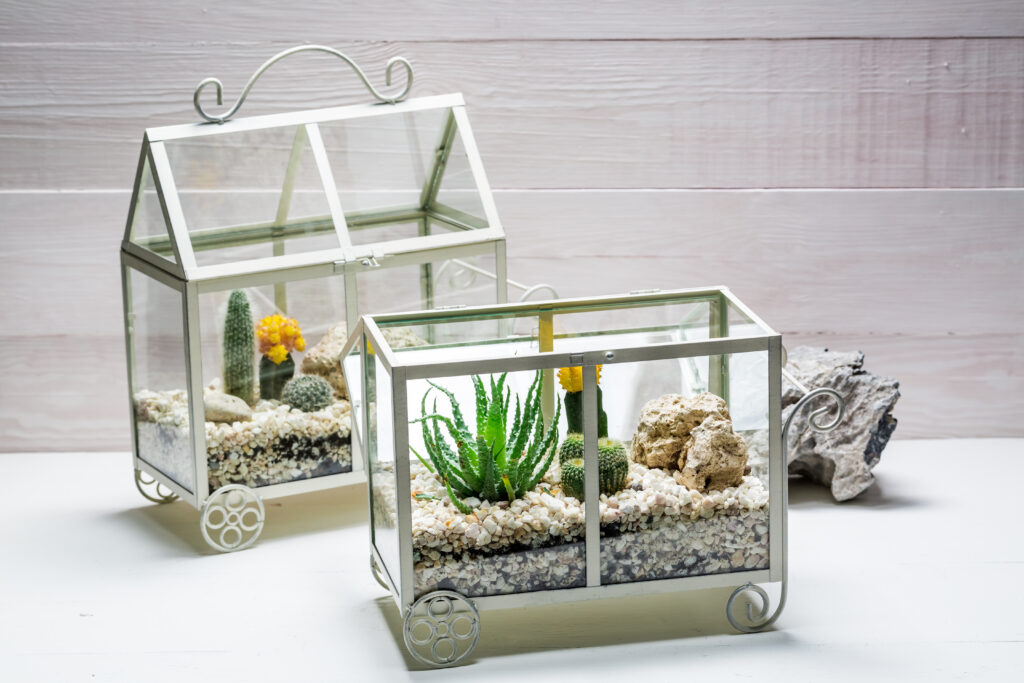Terrariums bring miniature ecosystems into your home, offering a creative way to display plants in stylish containers. Whether you’re a beginner or experienced plant enthusiast, understanding the difference between open terrariums and closed terrariums is essential for success with these container gardens.
Understanding Open vs. Closed Terrariums
Open Terrarium Basics
An open terrarium lacks a lid or cover, allowing for free airflow between the container and its surroundings. These container gardens create a drier environment ideal for plants that prefer lower humidity and good air circulation.
Closed Terrarium Characteristics
A closed terrarium features a lid or seal that creates a self-sustaining ecosystem. Water evaporates from the soil and plants, condenses on the glass walls, and returns to the soil—creating a continuous water cycle with minimal intervention needed.
Pros and Cons of Each Terrarium Type
Open Terrarium Advantages
- Lower humidity levels ideal for drought-tolerant plants
- Easier access for plant maintenance and arrangement adjustments
- Less risk of mold or fungal issues due to better air circulation
- Simpler to maintain proper soil moisture levels
Open Terrarium Disadvantages
- Requires more frequent watering as moisture evaporates
- Less dramatic visual effect without condensation on glass
- Collects dust more readily than closed systems
- Temperature fluctuations affect plants more directly
Closed Terrarium Benefits
- Self-sustaining water cycle requires minimal watering
- Higher humidity levels benefit tropical and moisture-loving plants
- Protected environment keeps out dust and household contaminants
- Fascinating microclimate with visible condensation cycles
Closed Terrarium Challenges
- Humidity control can be tricky to perfect
- Prone to mold and algae if overwatered
- Limited plant selection due to high humidity requirements
- Less accessible for maintenance once established

Best Plants for Open Terrariums
Open container gardens thrive with plants that prefer drier conditions and good airflow:
- Succulents: Echeveria, Haworthia, and Crassula varieties
- Air Plants (Tillandsia): Require no soil and minimal moisture
- Cacti: Small varieties like Mammillaria and Gymnocalycium
- Herbs: Rosemary, thyme, and sage enjoy the drier environment
- Snake Plants (Sansevieria): Compact varieties work well
Ideal Plants for Closed Terrariums
Closed terrariums favor plants that thrive in high humidity environments:
- Ferns: Maidenhair, button, and bird’s nest varieties
- Mosses: Sheet moss and cushion moss create lush carpets
- Peperomias: Watermelon, ripple, and baby rubber plant varieties
- Fittonias (Nerve Plants): Colorful veined leaves add visual interest
- Miniature Orchids: Many varieties thrive in humid terrariums
Humidity Control Tips for Both Systems
For open terrariums, place in areas with moderate light and avoid hot, direct sun that can scorch plants. Water sparingly, allowing soil to dry completely between waterings.
For closed terrariums, position in bright, indirect light and monitor condensation. If excessive moisture builds up, leave the lid off for a few hours. Water minimally—often just once every few months.
Creating Container Gardens That Last
Whether you choose an open or closed system, proper setup is critical. Use a layer of activated charcoal beneath your potting medium to keep the environment fresh, and select appropriate container sizes for your plants’ growth habits.
Remember that terrarium plants in either system should be miniature or slow-growing varieties to prevent overcrowding your container garden.




